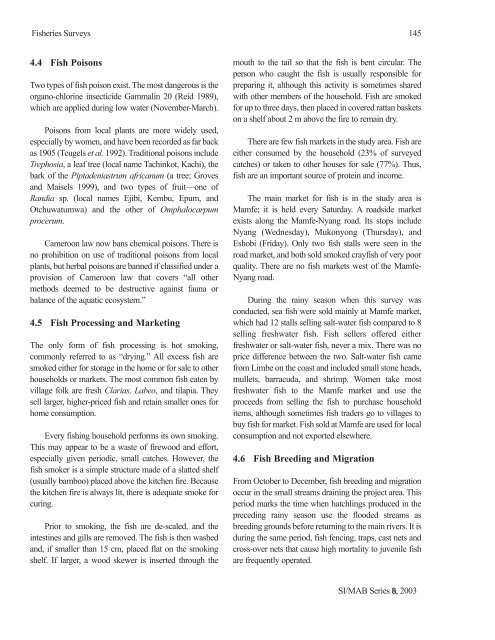Fisheries in the Southern Border Zone of Takamanda - Impact ...
Fisheries in the Southern Border Zone of Takamanda - Impact ...
Fisheries in the Southern Border Zone of Takamanda - Impact ...
You also want an ePaper? Increase the reach of your titles
YUMPU automatically turns print PDFs into web optimized ePapers that Google loves.
<strong>Fisheries</strong> Surveys<br />
4.4 Fish Poisons<br />
Two types <strong>of</strong> fish poison exist. The most dangerous is <strong>the</strong><br />
organo-chlor<strong>in</strong>e <strong>in</strong>secticide Gammal<strong>in</strong> 20 (Reid 1989),<br />
which are applied dur<strong>in</strong>g low water (November-March).<br />
Poisons from local plants are more widely used,<br />
especially by women, and have been recorded as far back<br />
as 1905 (Teugels et al. 1992). Traditional poisons <strong>in</strong>clude<br />
Trephosia, a leaf tree (local name Tach<strong>in</strong>kot, Kachi), <strong>the</strong><br />
bark <strong>of</strong> <strong>the</strong> Piptadeniastrum africanum (a tree; Groves<br />
and Maisels 1999), and two types <strong>of</strong> fruit—one <strong>of</strong><br />
Randia sp. (local names Ejibi, Kembu, Epum, and<br />
Otchuwatumwa) and <strong>the</strong> o<strong>the</strong>r <strong>of</strong> Omphalocarpum<br />
procerum.<br />
Cameroon law now bans chemical poisons. There is<br />
no prohibition on use <strong>of</strong> traditional poisons from local<br />
plants, but herbal poisons are banned if classified under a<br />
provision <strong>of</strong> Cameroon law that covers “all o<strong>the</strong>r<br />
methods deemed to be destructive aga<strong>in</strong>st fauna or<br />
balance <strong>of</strong> <strong>the</strong> aquatic ecosystem.”<br />
4.5 Fish Process<strong>in</strong>g and Market<strong>in</strong>g<br />
The only form <strong>of</strong> fish process<strong>in</strong>g is hot smok<strong>in</strong>g,<br />
commonly referred to as “dry<strong>in</strong>g.” All excess fish are<br />
smoked ei<strong>the</strong>r for storage <strong>in</strong> <strong>the</strong> home or for sale to o<strong>the</strong>r<br />
households or markets. The most common fish eaten by<br />
village folk are fresh Clarias, Labeo, and tilapia. They<br />
sell larger, higher-priced fish and reta<strong>in</strong> smaller ones for<br />
home consumption.<br />
Every fish<strong>in</strong>g household performs its own smok<strong>in</strong>g.<br />
This may appear to be a waste <strong>of</strong> firewood and effort,<br />
especially given periodic, small catches. However, <strong>the</strong><br />
fish smoker is a simple structure made <strong>of</strong> a slatted shelf<br />
(usually bamboo) placed above <strong>the</strong> kitchen fire. Because<br />
<strong>the</strong> kitchen fire is always lit, <strong>the</strong>re is adequate smoke for<br />
cur<strong>in</strong>g.<br />
Prior to smok<strong>in</strong>g, <strong>the</strong> fish are de-scaled, and <strong>the</strong><br />
<strong>in</strong>test<strong>in</strong>es and gills are removed. The fish is <strong>the</strong>n washed<br />
and, if smaller than 15 cm, placed flat on <strong>the</strong> smok<strong>in</strong>g<br />
shelf. If larger, a wood skewer is <strong>in</strong>serted through <strong>the</strong><br />
mouth to <strong>the</strong> tail so that <strong>the</strong> fish is bent circular. The<br />
person who caught <strong>the</strong> fish is usually responsible for<br />
prepar<strong>in</strong>g it, although this activity is sometimes shared<br />
with o<strong>the</strong>r members <strong>of</strong> <strong>the</strong> household. Fish are smoked<br />
for up to three days, <strong>the</strong>n placed <strong>in</strong> covered rattan baskets<br />
on a shelf about 2 m above <strong>the</strong> fire to rema<strong>in</strong> dry.<br />
There are few fish markets <strong>in</strong> <strong>the</strong> study area. Fish are<br />
ei<strong>the</strong>r consumed by <strong>the</strong> household (23% <strong>of</strong> surveyed<br />
catches) or taken to o<strong>the</strong>r houses for sale (77%). Thus,<br />
fish are an important source <strong>of</strong> prote<strong>in</strong> and <strong>in</strong>come.<br />
The ma<strong>in</strong> market for fish is <strong>in</strong> <strong>the</strong> study area is<br />
Mamfe; it is held every Saturday. A roadside market<br />
exists along <strong>the</strong> Mamfe-Nyang road. Its stops <strong>in</strong>clude<br />
Nyang (Wednesday), Mukonyong (Thursday), and<br />
Eshobi (Friday). Only two fish stalls were seen <strong>in</strong> <strong>the</strong><br />
road market, and both sold smoked crayfish <strong>of</strong> very poor<br />
quality. There are no fish markets west <strong>of</strong> <strong>the</strong> Mamfe-<br />
Nyang road.<br />
Dur<strong>in</strong>g <strong>the</strong> ra<strong>in</strong>y season when this survey was<br />
conducted, sea fish were sold ma<strong>in</strong>ly at Mamfe market,<br />
which had 12 stalls sell<strong>in</strong>g salt-water fish compared to 8<br />
sell<strong>in</strong>g freshwater fish. Fish sellers <strong>of</strong>fered ei<strong>the</strong>r<br />
freshwater or salt-water fish, never a mix. There was no<br />
price difference between <strong>the</strong> two. Salt-water fish came<br />
from Limbe on <strong>the</strong> coast and <strong>in</strong>cluded small stone heads,<br />
mullets, barracuda, and shrimp. Women take most<br />
freshwater fish to <strong>the</strong> Mamfe market and use <strong>the</strong><br />
proceeds from sell<strong>in</strong>g <strong>the</strong> fish to purchase household<br />
items, although sometimes fish traders go to villages to<br />
buy fish for market. Fish sold at Mamfe are used for local<br />
consumption and not exported elsewhere.<br />
4.6 Fish Breed<strong>in</strong>g and Migration<br />
145<br />
From October to December, fish breed<strong>in</strong>g and migration<br />
occur <strong>in</strong> <strong>the</strong> small streams dra<strong>in</strong><strong>in</strong>g <strong>the</strong> project area. This<br />
period marks <strong>the</strong> time when hatchl<strong>in</strong>gs produced <strong>in</strong> <strong>the</strong><br />
preced<strong>in</strong>g ra<strong>in</strong>y season use <strong>the</strong> flooded streams as<br />
breed<strong>in</strong>g grounds before return<strong>in</strong>g to <strong>the</strong> ma<strong>in</strong> rivers. It is<br />
dur<strong>in</strong>g <strong>the</strong> same period, fish fenc<strong>in</strong>g, traps, cast nets and<br />
cross-over nets that cause high mortality to juvenile fish<br />
are frequently operated.<br />
SI/MAB Series #8, 2003

















